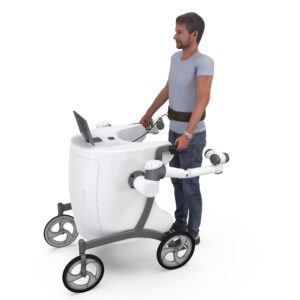In the healthcare industry, the integration of technology can significantly enhance patient care and improve operational efficiencies. Among the groundbreaking developments, Rose, a caregiver robot, is emerging as a pivotal innovation. This robotic walker is not just a tool for mobility; it’s reshaping the roles of caregivers, fostering patient independence, and setting new benchmarks in healthcare robotics. This article explores how Rose is revolutionizing the healthcare sector by offering robust support and newfound independence to those who need it most.
How Rose is Making a Difference
Enhanced Patient Mobility Rose, designed as a physically assistive robotic walker, offers more than just support for movement. It incorporates advanced sensors and software that allow it to adapt to the user’s pace and needs, providing stability and confidence to patients with mobility issues. Unlike traditional walkers, Rose can anticipate obstacles, reduce fall risk, and even navigate through tight spaces, making it an invaluable companion for daily activities.
Empowering Patients with Independence One of the most significant impacts of Rose is its ability to empower patients. By providing assistance that adjusts to individual needs, patients can perform many daily tasks independently, reducing their reliance on human caregivers for basic movements and activities. This autonomy can lead to significant improvements in mental health and overall quality of life.
Support for Caregivers Caregivers also benefit immensely from Rose. With Rose handling some of the physical demands of caregiving, professionals can focus more on other critical aspects of care, such as the emotional and psychological needs of their patients. This not only improves the quality of care but also reduces caregiver burnout, a common issue in the healthcare sector.
Integration with Healthcare Systems Rose is designed to seamlessly integrate into existing healthcare systems. It can collect data on patient activity levels, monitor health indicators, and even sync with medical records to provide a comprehensive overview of a patient’s health status. This data-driven approach allows for better-informed decisions, tailored care plans, and improved outcomes.
The Future of Healthcare Robotics
Trends and Innovations The success of Rose highlights a growing trend in healthcare: the rise of assistive robotics. As technology advances, we can expect to see more robots with enhanced cognitive and emotional intelligence capabilities, making them even more effective in personalized care.
Challenges and Considerations Despite the promise of robotic assistants like Rose, there are challenges to address, such as ensuring privacy and security of patient data, improving the affordability of robotic solutions, and overcoming cultural and psychological barriers to adoption.
Rose the caregiver robot is more than just a technological marvel; it’s a transformative force in healthcare. By enhancing patient mobility, empowering independence, and supporting caregivers, Rose is not only improving lives but also guiding the future of healthcare robotics. As we look forward, the potential for further integration of robotics in healthcare promises even more exciting developments that could redefine care standards globally.

